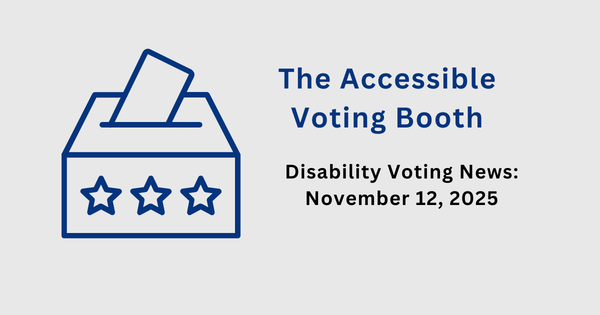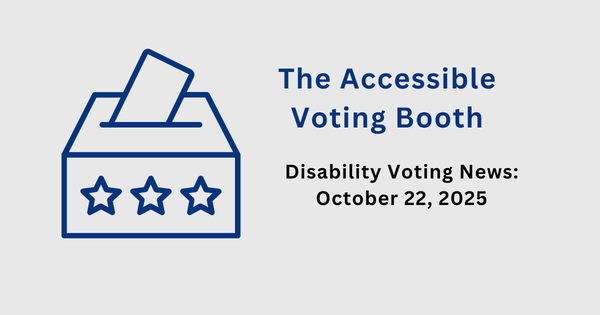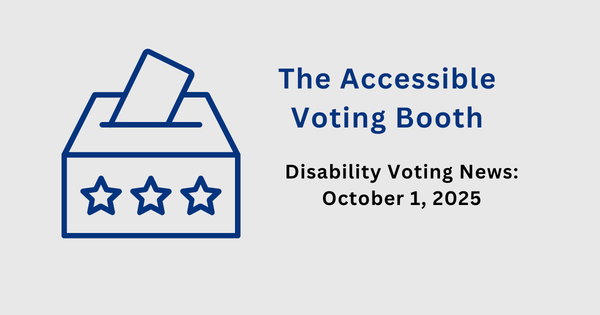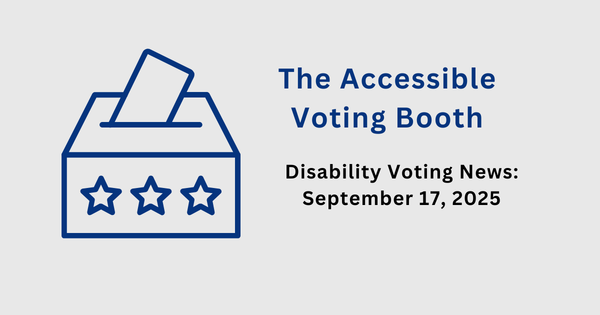Disability Voting News: August 20, 2025
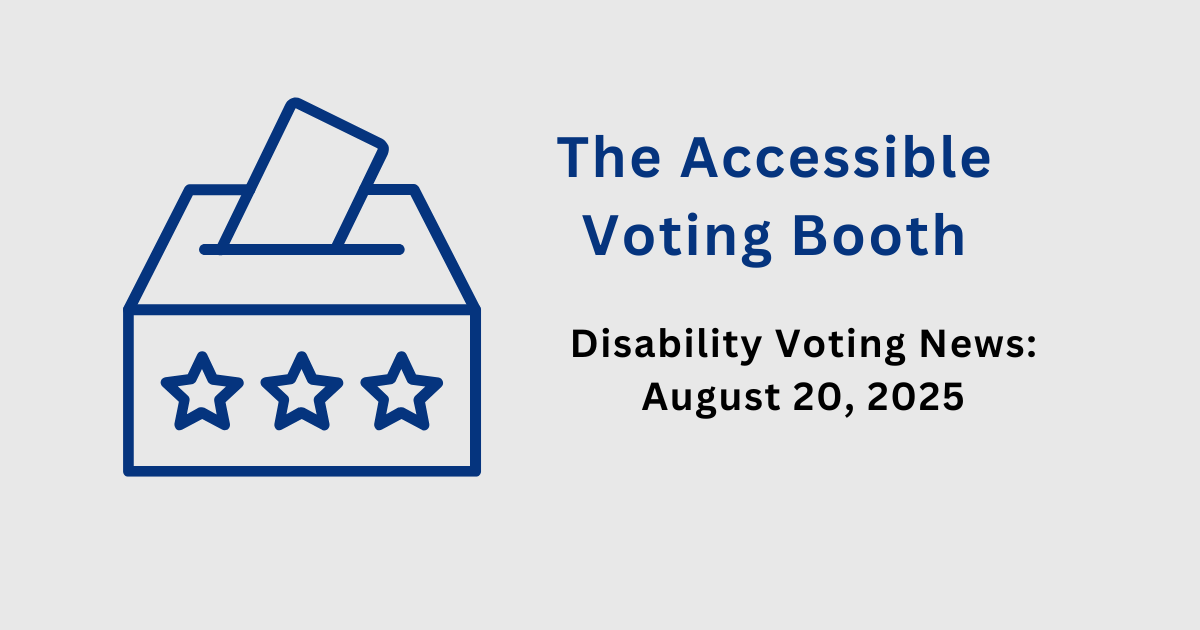
Welcome to the Accessible Voting Booth for August 20th. Today, we're discussing Trump's threat to attempt to ban mail-in voting and voting machines via Executive Order, and recent comments around election officials' obligation to provide accessible polling places in Detroit.
Trump vows to target mail-in ballots and voting machines ahead of 2026 midterm election (via Reuters).
On Monday, President Trump threatened to issue an (unconstitutional) Executive Order to end the use of mail-in ballots and voting machines ahead of the 2026 midterm elections. Both mail-in voting and voting machines are essential options for millions of voters with disabilities.
"I am going to lead a movement to get rid of MAIL-IN BALLOTS, and also, while we're at it, Highly 'Inaccurate,' Very Expensive, and Seriously Controversial VOTING MACHINES," Trump posted on social media.
I’m unclear on whether Trump is referring to ballot-marking devices or tabulators, and I believe he means both, as he has repeatedly called for both hand-marked paper ballots and hand counts of elections (which are less accurate than tabulators). As we’ve discussed many times, every polling place is required to have at least one accessible voting machine thanks to the Help America Vote Act of 2002, which requires that voters with disabilities have the same opportunity to vote privately and independently. Without accessible voting machines, millions of voters with disabilities would not be able to independently vote, and they would have to rely on assistance from a poll worker or a helper (another thing that many states have attempted to limit). This includes:
- Voters who are blind or have low vision, who use the machine to increase the text size or to have the machine read the ballot out over headphones.
- Voters who have mobility disabilities that make it difficult or impossible to independently mark their ballot with a pen.
- Voters who have cognitive disabilities or low literacy who benefit from using an audio ballot.
- Any voter who feels more comfortable voting on an accessible machine, for whatever reason.
To eliminate accessible voting machines would eliminate the mechanism for private and independent voting for literally millions of Americans, although as we know from this administration, the cruelty and voting suppression is the point.
Millions of voters also utilize mail-in voting, and this option is beneficial for many voters with disabilities who may have difficulty going to a polling place. Voting by mail is more accessible for some voters who would otherwise encounter barriers at the polling place. In an analysis of voting access barriers in the 2020 election, Rutgers University professors Doug Kruse and Lisa Schur found that the percent of voters who experienced access barriers in the polling place dropped from 30% in 2012 to 18% in 2020, and while improvement in polling place accessibility played a part, “about half of the 12-point drop in polling place difficulties from 2012 to 2020 appears due to people with more severe disabilities switching to voting by mail.” Additionally, they found that voters with disabilities were more likely than voters without disabilities to vote by mail in 2020.
Voting by mail is essential for voters who have difficulty traveling to the polling place or accessing reliable transportation, as well as voters who have energy-limiting disabilities or illnesses that make leaving the home difficult or impossible. It is also vital for many voters in rural areas. For example, in 2024, 68% of Montana voters requested absentee ballots. In rural communities, getting to the nearest polling place may require hours of travel.
This potential executive order would be another overreach by the Trump Administration to interfere in the election process, and it would be catastrophic for millions of Americans with disabilities. I’m sure that voting rights and disability rights organizations are gearing up for this fight, and I will keep you updated on whether an EO to limit mail-in voting and accessible voting machines comes to fruition.
Note: in the time since I drafted this newsletter on Monday, Julia Métraux at Mother Jones covered the disability community's reaction to this proposed Executive Order: "Trump's Promise to End Vote-by-Mail is Yet Another Attack on Disabled Voters."
Detroit Disability Power responds to inaccurate comments on voting accessibility from Detroit City Clerk (via WDET).
On Monday, August 4, Detroit City Clerk Janice Winfrey claimed that fewer than five polling places (out of close to 200 polling places) in the city of Detroit have accessibility problems. Furthermore, she stated that “election law speaks to that the entrance of the polling location must be accessible, that’s it. And then of course, we have the machines, the accessible machines…but other than that, that’s it.”
Detroit Disability Power, which regularly audits polling places in the Detroit Metro area for accessibility, has pushed back, reiterating that in their survey of 167 polling locations in Detroit, half had issues at the doorway and 70% had issues with the accessible voting machines, called Voter Access Terminals in Michigan.
Discussing DDP’s most recent audit which took place the day after Clerk Winfrey’s comments, Eric Welsby, Policy Director for DDP, stated:
“We were in all the polling places last week. We just revisited them, and I can tell you more than five sites were not in compliance again. And you know, some of the problems were ones we saw before, some were new, but these problems persist and our real question is, how can we fix them?”
Eric said that DDP’s goal is to turn around the data from their recent audit to provide to the clerk two months before the November election to provide useful information and recommendations on how the clerk and poll workers can improve election accessibility in November. Note: through my work with The Carter Center, I work closely with Detroit Disability Power to conduct data analysis and assist with drafting DDP's reports about polling place accessibility. This newsletter and the following opinions and discussion are my views only, and not representative of Detroit Disability Power or The Carter Center.
Clerk Winfrey’s claim that election law only dictates that entrances and accessible voting machines are accessible is incorrect. The Voting Accessibility for the Elderly and Handicapped Act (VAEHA), which predates the Americans with Disabilities Act by several years, requires all polling place facilities to be accessible to individuals with disabilities. Neither VAEHA nor the ADA specifically limit accessibility to address only the entrances of polling places. Instead, accessibility can be broadly interpreted as requiring accessibility for many different types of voters with disabilities across the polling place.
Title II of the Americans with Disabilities Act requires government entities to give people with disabilities “an equal opportunity to benefit from all their programs, services, and activities,” and this requirement extends to all aspects of voting. The U.S. Department of Justice has provided an ADA Checklist for Polling Places to help election officials vet polling places for compliance, and the DOJ states:
“The ADA requires that public entities ensure that people with disabilities can access and use all of their voting facilities. Because a mix of public and private facilities are used as polling places, public entities may ensure Election Day accessibility of a polling place by using low-cost temporary measures, such as portable ramps or door stops, rather than necessarily making permanent modifications to a facility.”
The ADA Checklist for Polling Places draws on the ADA Standards for Accessible Design and lays out the accessibility features that are required for accessible polling places. The checklist addresses what it calls “key areas or features that must be accessible: “the parking area and passenger drop-off sites; routes (both exterior and interior); the entrance to the polling place; and the voting area itself.” It provides detailed and explicit guidance for parking, passenger drop-off locations, paths of travel, ramps, protruding objects, the building entrance, and lifts and elevators.
Clearly, these accessibility obligations extend beyond simply the accessible voting equipment and doorways of the polling place and cover the entire polling place, as they should. If election officials only looked at the accessibility of the doorway and the voting machines, so many parts of the polling place would be able to remain inaccessible, from a lack of accessible parking, to stairs in front of a building without a ramp or lift, to objects obstructing paths of travel, to lack of room to maneuver a wheelchair to an accessible voting machine.
Beyond federal requirements, Michigan state statutes reaffirm the application of federal accessibility laws to non-federal elections. MCL 168.662 of Michigan Election Law requires city and township governments to abide by provisions of the VAEHA and Help America Vote Act (which requires accessible voting equipment).
DDP’s data continue to show significant accessibility issues in Detroit, and there are far more than five polling places that have these issues. Many entrances continue to be plagued by accessibility barriers, from steps with insufficient (or no) ramps, to large objects propping open doors and obstructing the paths of travel, to doors that are too heavy to open or have broken door opener buttons. VATs continue to have accessibility issues as well, particularly when they are not set up to afford voters privacy with voting or lack equipment such as headphones or controllers. DDP is putting this information together not to chide election officials, but to provide useful information on how election officials can improve accessibility so that every voter has equal access to the polling place. Hopefully Clerk Winfrey will listen to DDP and work with them to improve these accessibility barriers.
As always, if you’d like to support the newsletter and my work, here’s how:
- Subscribe to the Accessible Voting Booth newsletter.
- Share this newsletter with your network to spread the word about disability voting rights.
- Leave me a tip. Thank you for supporting my work!

